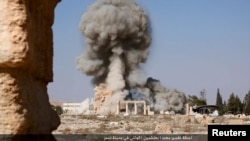The rapid growth of the self-styled Islamic State is due in part to a sophisticated media campaign that has attracted tens of thousands of fighters from more than 100 countries, and that number is growing by the day. A newly released study of the IS media "machine" shows it to be carefully orchestrated for maximum appeal.
Charlie Winter, a senior researcher at the London-based Quilliam Foundation, collected and analyzed hundreds of IS media messages, including tweets, photographs, audio statements, online articles and videos. He then sorted them into six basic narratives: mercy, belonging, brutality, victimhood, war and utopia. The result is the study "Documenting the Virtual 'Caliphate.' "
“I was expecting a preponderant amount of focus on utopia,” said Winter. “I was expecting less brutality than people speak about. But what I wasn’t expecting was the sheer volume of it all. It really indicated to me that a lot more effort than I think people give the Islamic State credit for is being put into the propaganda operation.”
In the 16 months since it declared itself, Winter said, the Islamic State has shifted its narrative to suit changing strategic policies.
“Last year, they were focused on expansion — rapid, rapid expansion — and getting as much infamy and fear and intimidation as possible amongst regional adversaries and outside the region. So we saw beheadings, Jihadi John, themes that were really aimed at provoking an international response and outraging as many people as possible,” said Winter.
Today, he said, the Islamic State is working to consolidate control over the territory it has gained in Syria and Iraq. Brutality now plays a lesser role — “only 19 out of 1,146 separate propaganda events,” said Winter. And the people shown being killed were predominantly Syrian or Iraqi, said to be members of intelligence forces, responsible for giving information to the coalition to direct airstrikes. "When they are being killed, they are being killed to deter people from engaging in espionage or dissent.”
Countering IS messages
Winter thinks that if the West is to make any progress in the war against Islamic State, it is going to have to understand the group's vision of utopia. That vision, well-described by journalist and scholar Graeme Wood in The Atlantic, is the restoration of an idealized seventh-century Islamic Golden Age.
Governed by Islamic laws and values, an orderly, prosperous, safe and idyllic society is painstakingly re-created in IS online messages.
“There’s economic activity, so showing things like industry or markets full of goods and fresh vegetables,” he said. "There’s agriculture, service provision, hospitals, education. Wildlife and landscape.”
The videos also seek to portray a functioning judicial system, based on sharia law.
Winter believes the solution for state and nonstate actors who wish to push back against the IS message is to offer a compelling, competing counternarrative.
“It could focus on the West’s humanitarian work or on receiving refugees into Europe — and perhaps not spraying them with tear gas, as has been done in Eastern European countries recently,” Winter said. “Things that are based upon positive action.”
Root of the problem
But some experts say that trying to counter IS in social media fails to address the root of the problem.
“A better Facebook page or better commercial appeal through videos won’t change the fact that there are thousands and thousands of young people, mostly young men, living in difficult conditions and are therefore looking for some way to escape," said Rami Khouri, director of the Issam Fares Institute for Public Policy and International Affairs at the American University of Beirut.
Khouri blames Western foreign policy, its support of regional dictators, its militarism and its ongoing support of Israel and failure to broker a Middle East peace agreement.
But that’s an argument Albert Fernandez isn’t buying.
Vice president of the Washington-based Middle East Media Research Institute, an Arabic media watchdog group, Fernandez left his former position heading the U.S. State Department’s Center for Strategic Counterterrorism Communications over differences in opinion about how best to counter IS propaganda.
“What Khouri’s saying may be right on a certain level. But it’s also unrealistic,” Fernandez said. “Governments have their relations and they have interests. And to be frank, the ISIS argument — yeah, sure, it’s about an artificial, imaginary, perfect utopian future compared to the humdrum, corrupt, lousy reality that some people experience. But it’s also about fantasy.”
He is referring to the apocalyptic dimension of the IS narrative, which portends a final, epic battle against infidels in Jerusalem and the arrival of the Mahdi ["the guided one"] to fight on Islam’s behalf.
“So to say that if US foreign policy were more just, there would be less of an appeal? Sure," Fernandez said. "But the largest number of ISIS fighters anywhere in the world come from one of the few democratic countries strongly supported by the U.S. — Tunisia.”
Fernandez believes the answer, in part, lies in defeating IS militarily, on the ground.
“Second, when you talk about the sheer weight of the material that they have in social media, you need to do more. They outnumber the good guys. You need more good guys,” he said.
And finally, he believes that countering ISIS involves taking on the religious argument.
“Governments are clumsy and uneasy about doing this, and perhaps they should be uneasy about doing it. But it doesn’t mean it doesn’t need to be done,” he said.













